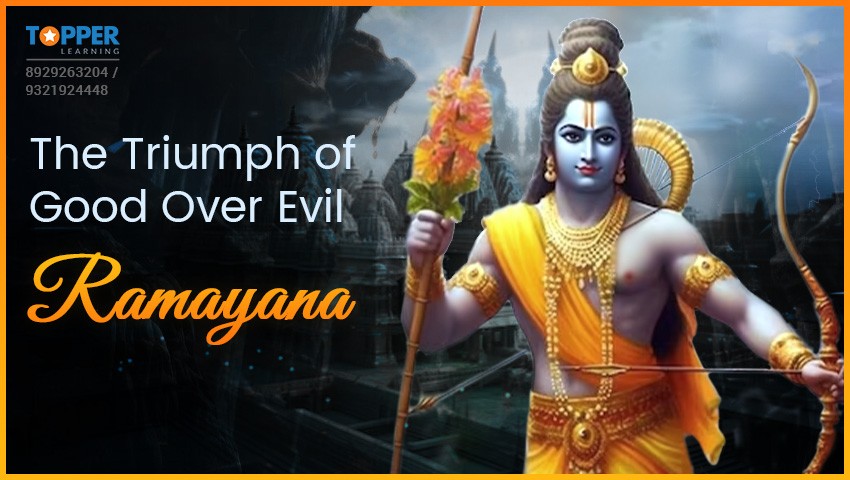The Triumph of Good Over Evil: Ramayana

Ramayana is an important religious Hindu scripture that tells the tale of Lord Rama. It is written by the sage Valmiki. It is the story of the victory of good over evil, how Lord Rama won the battle against Ravana to reunite with Goddess Sita.
By Topperlearning Expert 19th Jan, 2024 | 06:54 pm
ShareEveryone in India is excited and planning a joyous celebration on 22nd January 2024. The day is an auspicious occasion for Hindus around the world since, after a wait of many years, the Ram Mandir is being built in the birthplace of Lord Ram, Ayodhya. The honourable Prime Minister of India is inaugurating the Ram Mandir in Ayodhya on 22nd January. Many famous celebrities and dignitaries are invited to this occasion. The Ram Mandir has been trending significantly across the internet as videos and songs are being created for this occasion. Every Hindu feels like it's an early Diwali for them since their Lord Rama is finally coming home, Ayodhya. Let us learn about the epic tale of Lord Rama and what is the significance of Ramayana and the Ram Mandir.
Ramayana: The Hindu Scripture
Ramayana, which means ‘the journey of Rama,’ is one of the most epic tales of the righteous prince in the Treta Yuga in the Hindu religious texts. It was written by sage Valmiki in the Sanskrit language and is dated to around 200 BCE. The story is composed in the form of a very long poem of 24,000 couplets divided into seven books. There are many versions of Ramayana available around the world, but the Valmiki Ramayana is considered the most significant and true depiction of the story of Lord Rama. The story is about how Rama killed Ravana, who abducted his wife Sita.
The Tale of Rama
On the banks of the river, Sarayu was the kingdom of King Dasaratha in Ayodhya. Ayodhya was the capital city of Kosala. King Dasaratha had three wives: Kausalya, Kaikeyi, and Sumitra. Rama was the eldest son of the king and had three younger brothers, Bharata, Lakshman, and Shatrughan. He is known as the seventh incarnation of Lord Vishnu and was the human form to kill Ravana. The people of Ayodhya were very peace-loving and had great love and respect for their king and the four princes. Rama was the most beloved son of Dasaratha.
The Union of Rama and Sita
When Rama was 16 years old, sage Vishwamitra requested King Dasaratha to let him take Rama to fight against the demons. Rama and Lakshman went with Vishwamitra and defeated the she-demon Tataka. The three of them headed to Mithila to meet King Janaka. King Janaka gave them a warm welcome and introduced Vishwamitra to his beautiful daughter, Sita, who was born from the Earth and adopted by King Janaka. King Janaka was looking for an ideal, strong, and righteous groom for his daughter. He presented a challenge that the man who would be able to lift Shiva’s bow and tie the string to it would marry Sita. The room full of princes and kings failed even to lift the bow; only Rama was able to lift the bow, and as he tried to tie the string, the bow broke and fell. Sita was given in marriage to Rama. They returned to Ayodhya, and everyone welcomed them with joy.
After many years, when King Dasaratha was growing old, he decided to make his oldest son, Rama, the king of Ayodhya. Rama was noble, righteous, strong, honest, caring, and loved by everyone in Ayodhya. When the news of Rama being the king spread, Manthra, a servant of Kaikeyi, convinced Kaikeyi to ask the king to make Bharata the king and send Rama to 14 years of exile. Kaikeyi asked the king under a promise and sent Rama to exile. Laxman and Sita joined Rama in his exile, and Bharata did not take the title of the king of Ayodhya as he believed his brother Rama was the rightful king.
The Exile
While Rama, Sita and Laxman were in exile, one day, Sita saw a golden deer (a demon in disguise) and requested Rama to get it for her. Rama went after the deer, and Laxman followed him, created a protective circle around their hut, and requested Sita not to come out until they returned home. Ravana came dressed as a sage and requested Sita for some food. When Sita tried to give him the food, he abducted her and took her to his kingdom in Lanka.
Rama and Lakshman tried to find Sita throughout the forest but could not find her. Jataiyu, the great eagle, spotted Ravana taking Sita to Lanka and lost his life trying to save Sita. With the help of Hanuman and the king of Kishkinda, Sugriva, they formed an army, the Vanar Sena (an army of monkeys and other forest animals), to fight against Ravana and rescue Sita.
The Battle
Ravana was a demon who was loathed with gold and power. He was a devotee of Lord Shiva and was awarded ten heads and the blessing, only to be killed by a normal man by him. Rama and his army built a bridge (traces of the bridge known as the Ram Setu, located in the Indian Ocean) across the ocean to reach Lanka and fought a great battle against Ravana and his army. Rama defeated Ravana and was reunited with Sita. Rama, Sita, Laxman, and Hanuman returned to Ayodhya, where Rama and Sita were crowned king and queen. The people of Ayodhya celebrated this victorious day as Diwali and lit up the city with diyas.
The story of Lord Rama’s struggle, devotion, respect, and dedication shows that no matter how much power and wealth you have, good will always win over evil.
Difference between Ramayana and Ramcharitramanas
People often mix the Hindu literature, Ramayana, and Ramcharitrsmanas. Given are some of the differences between Ramayana, and Ramcharitrsmanas.
|
Ramayana |
Ramcharitramanas |
|
It is written in the Treta Yug by the sage Valmiki in the Sanskrit language. |
It is written in the Kali Yug by Tulsi Das in the Awadhi language. |
|
According to Ramayana, Lord Hanuman was a human and a part of the animal tribe. |
According to the Ramacharitmanas, Lord Hanuman was not a human, but he was a monkey. |
|
The Ramayana describes Lord Rama as a human being with extraordinary morality, wisdom, and memory. |
Ramcharitmanas states that Lord Rama was described as an 'Avataar' of Lord Vishnu in human form. As a result, his acts were seen as the right course of action to defeat Ravana's "Evil" and restore Dharma to the world. |
Bottom Line
The tale of Lord Rama is a beautiful journey that depicts the importance of various virtues throughout our lives. There are several teachings in the Ramayana to learn. The biggest lesson learned is that no matter what happens, truth and good will always prevail and win over evil. As said by Lord Rama himself, ‘One who is virtuous and wise, just and merciful, is a true human.’
Test Your Knowledge
Q 1. Lakshman is the incarnation of whom?
a. Lord Shiva
b. Lord Brahma
c. Sheshnag
d. Lord Vishnu
Ans. c. Sheshnag
As Rama was the incarnation of Lord Vishnu, Lakshman was the incarnation of Sheshnag.
Q 2. Who was the brother of Sugriv?
a. Angad
b. Megnath
c. Bali
d. Jatayu
Ans. c. Bali was the brother of Sugriv and the king of Kishkinda.
Q 3. What was the name of Lord Rama’s sons?
a. Luv and Kusha
b. Bharat and Shatrughan
c. Angad and Dharmaketu
d. Arjun and Sahadeva
Ans. a. Luv and Kusha
Luv and Kusha were the twin sons of Lord Rama and Goddess Sita.
Q 4. What was the name of Lakshman’s wife?
a. Subhadra
b. Madhvi
c. Mandodari
d. Urmila
Ans. d. Urmila
Urmila was the wife of Lakshman. She was the daughter of King Janak and sister of Sita.
Q 5. Who used to participate in wars with King Dasaratha?
a. Kaushalya
b. Sita
c. Kaikeyi
d. Sumitra
Ans. c. Kaikeyi
Kaikeyi was the third wife of King Dasaratha and the mother of Bharat.
More from Education
Important Resources
- Education Franchisee opportunity
- NCERT Solution
- CBSE Class 9 Mathematics
- NCERT Solutions for class 10 Science
- Sample Papers
- CBSE Class 9 Science
- NCERT Solutions for class 10 Maths
- Revision Notes
- CBSE Class 10 Hindi
- CBSE Class 10 English
- CBSE Class 10 English
- CBSE Class 10 Social Studies
- CBSE Class 10 Science
- CBSE Class 10 Mathematics
- Career In Science After 10
- Career In Commerce After 10
- Career In Humanities/Arts After 10
- NCERT Solutions for Class 10
- NCERT Solutions for Class 11
- Business Studies Class 12 CBSE project





